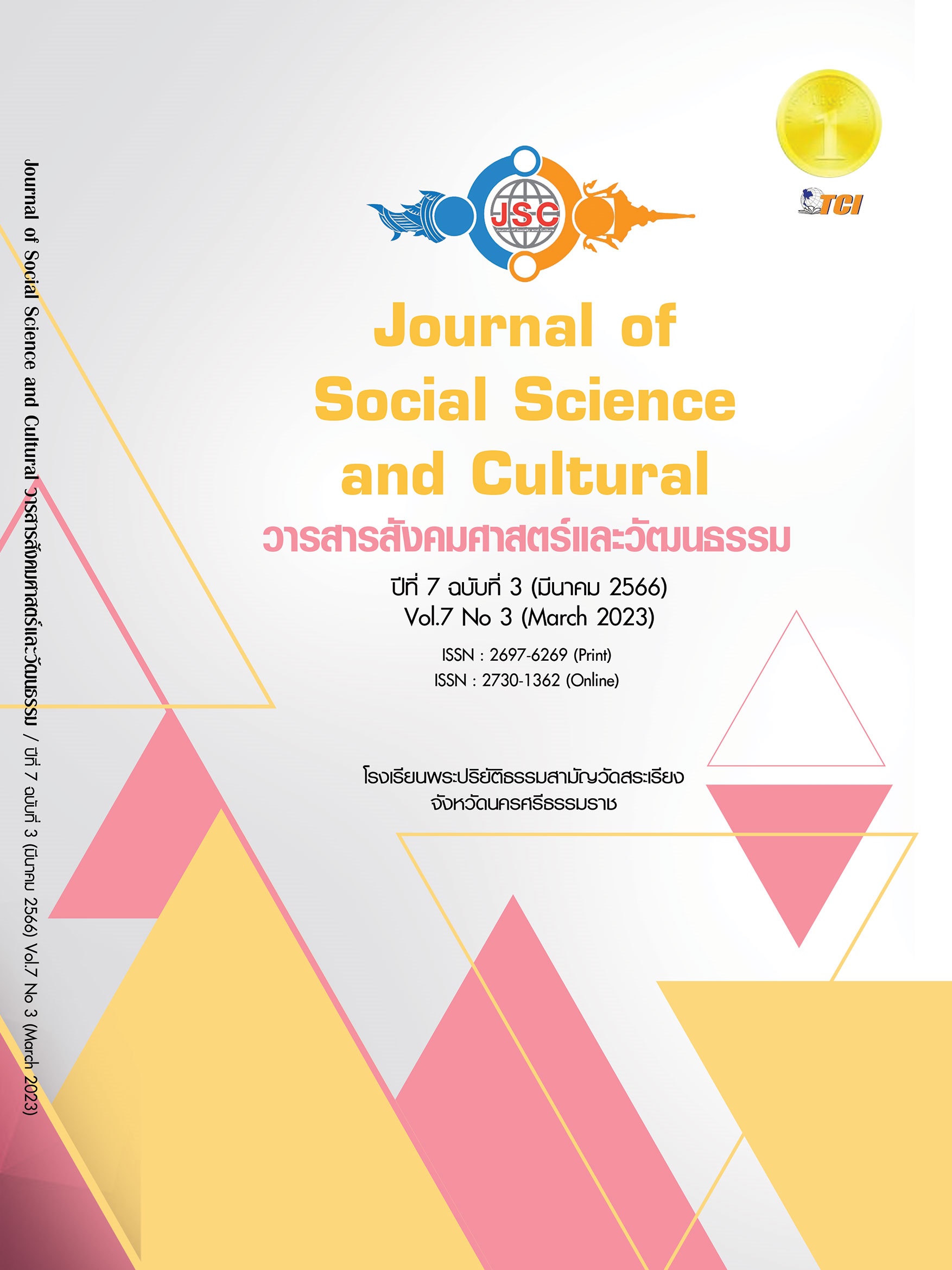การวัดความร่วมรู้สึกในผู้มีส่วนได้ส่วนเสียของหลักสูตรผู้ประกอบการเพื่อความยั่งยืนสำหรับผู้เรียนระดับอุดมศึกษาโดยการวัดคลื่นไฟฟ้าสมองด้วยเทคนิคอีอีจี
Main Article Content
บทคัดย่อ
บทความวิจัยนี้มีวัตถุประสงค์เพื่อเปรียบเทียบคลื่นไฟฟ้าสมองด้านความร่วมรู้สึกในผู้มีส่วนได้ส่วนเสียของหลักสูตรผู้ประกอบการเพื่อความยั่งยืนสำหรับผู้เรียนระดับอุดมศึกษา เป็นการวิจัยเชิงปริมาณ โดยแบ่งการดำเนินงานเป็น 2 ขั้นตอน ดังนี้ 1) ศึกษาเอกสารและทบทวนวรรณกรรมที่เกี่ยวข้องกับแนวคิดทฤษฎี 3 หัวข้อ ได้แก่ ผู้ประกอบการเพื่อความยั่งยืน ความร่วมรู้สึก การวัดคลื่นไฟฟ้าสมองโดยเทคนิคอีอีจี 2) พัฒนาเครื่องมือวัดความร่วมรู้สึกในผู้มีส่วนได้ส่วนเสีย กลุ่มตัวอย่าง คือ อาสาสมัครผู้กำลังศึกษาในระดับอุดมศึกษา จำนวน 30 คน โดยการเลือกกลุ่มตัวอย่างแบบเจาะจง เครื่องมือที่ใช้ในการวิจัย ได้แก่ เครื่องมือการคัดกรองกลุ่มตัวอย่างโดยใช้แบบสอบถาม แบบทดสอบทางจิตวิทยาด้วยโปรแกรม OpsenSesame version 3.3.11 ภาพเกี่ยวกับสิ่งแวดล้อมที่ดี จำนวน 30 ภาพ สิ่งแวดล้อมที่ไม่ดี จำนวน 30 ภาพ ความเป็นอยู่ที่ดีของผู้มีส่วนได้ส่วนเสีย จำนวน 30 ภาพ ความเป็นอยู่ที่ไม่ดีของผู้มีส่วนได้ส่วนเสีย จำนวน 30 ภาพ เครื่องมือการวัดและบันทึกคลื่นไฟฟ้าสมอง โดยโปรแกรม EmotivePRO version 3.2.3.420 วัดคลื่นไฟฟ้าสมองด้านความร่วมรู้สึก (Mu) ที่คลื่นความถี่ 8 – 12 เฮิรต์ที่บริเวณเปลือกสมองสั่งการ (Motor Cortex) และเปลือกสมองรับความรู้สึก (Sensorimotor cortex) ระหว่างการทำกิจกรรมทดสอบความร่วมรู้สึกในผู้มีส่วนได้ส่วนเสียก่อนและหลังเรียนหลักสูตรผู้ประกอบการเพื่อความยั่งยืน โดยตรวจสอบคุณภาพเครื่องมือได้ค่าสัมประสิทธิ์แอลฟาของครอนบาคเท่ากับ .73 วิเคราะห์ข้อมูลเชิงปริมาณโดยสถิติเชิงพรรณนา ได้แก่ ร้อยล่ะ ความถี่ ค่าเฉลี่ย ส่วนเบี่ยงเบนมาตรฐาน ค่าสถิติทดสอบ t-test ค่าอิทธิพลความแตกต่าง ผลการวิจัยพบว่าผู้เรียนมีค่าเฉลี่ยคลื่นความร่วมรู้สึกในผู้มีส่วนได้ส่วนเสียสูงกว่าก่อนเรียนหลักสูตร
Article Details
เอกสารอ้างอิง
กรมควบคุมมลพิษ. (2564). รายงานสถานการณ์และการจัดการปัญหามลพิษทางอากาศและเสียงของประเทศไทย ปี 2564. เรียกใช้เมื่อ 15 มกราคม 2566 จาก https://www. pcd.go.th
กรมพัฒนาชุมชน กระทรวงมหาดไทย. (2564). รายงานคุณภาพชีวิตของคนไทยปี 2564. เรียกใช้เมื่อ 18 มกราคม 2566 จาก https://app2.cdd.go.th/rdic/report/BMN/ ReportBMN64.pdf
สภาปฏิรูปแห่งชาติ. (2558). สภาปฏิรูปแห่งชาติ. (ม.ป.ป.). วาระปฏิรูปพิเศษ 1: วิสาหกิจเพื่อสังคม. เรียกใช้เมื่อ 5 มกราคม 2566 จาก https://www.parliament.go.th/ ewtadmin/ewt/parliament_parcy
Austin, J., Stevenson, H. & Wei-Skillern, J. (2006). Social and Commercial Entrepreneurship: Same. Different, or Both? Baylor University, 30(1), 1-22.
Breil, C., et al. (2021). A Revised instrument for the assessment of empathy and Theory of Mind in adolescents: Introducing the EmpaToM-Y. Behavior Research Methods, 53(6), 2487-2501.
Cronbach, L. J. (1984). Essentials of Psychological Testing. New York: Harper & Row.
Dongen.J. D. M. V. . (2020). The Empathic Brain of Psycholopaths: From Social Science to Neuroscience in Empathy. Frontiers in Psychology, 11(695), 1-12.
Elkington, J. (1994). Toward the Sustainable Corporation: Win-Win-Win Business Strategies for Sustainable Development. California Management Review, 36(1), 90-100.
Janie M., Circovic, M.,et al. (2022). Neuroscience and CSR: Using EEG for Assessing the Effectiveness of Branded Videos Related to Environmental Issues. Sustainability, 14(1347), 1-18.
Peled, A. L. (2016). The role of empathy in the neural responses to observed human social touch. Cognitive Affect Behavioral Neuroscience, 16(5), 802-813.
Simone, D. S., et al. (2016). Engaging Public Servants: Public Service Motivation, Work Engagement and Work-Related Stress. Management Decision, 54(7). 1569-1594.
United Nations. (2017). Promoting Entrepreneurship for Sustainable Development: A selection of business cases from the empretec network. United Nations: Conference on Trade and Development.
Xu, G., Hou, G. & Zhang, J. (2022). Digital Sustainable Entrepreneurship: A Digital Capability Perspective through Digital Innovation Orientation for Social and Environment Value Creation. Sustainability, 14(18), 1-24.


